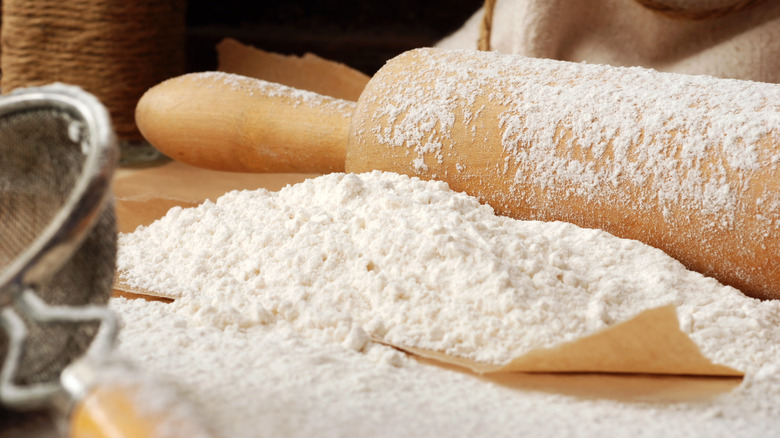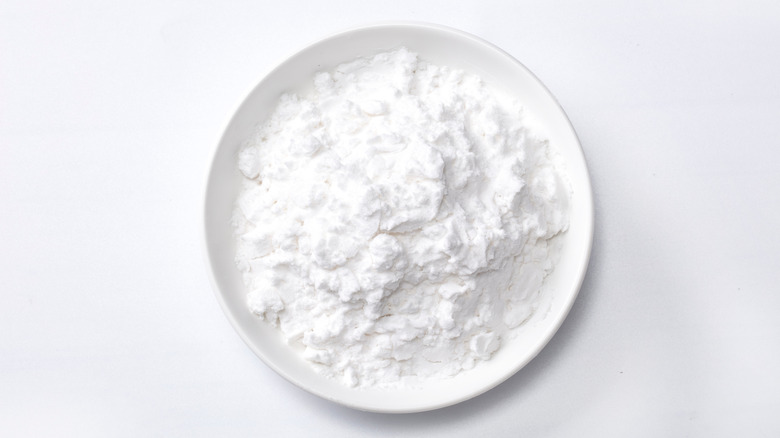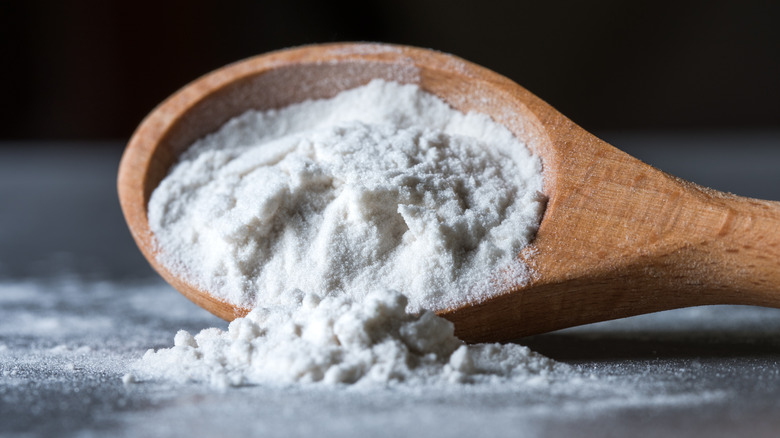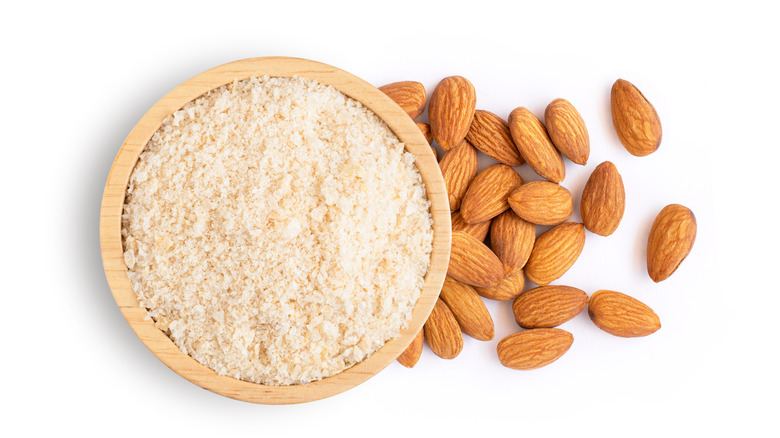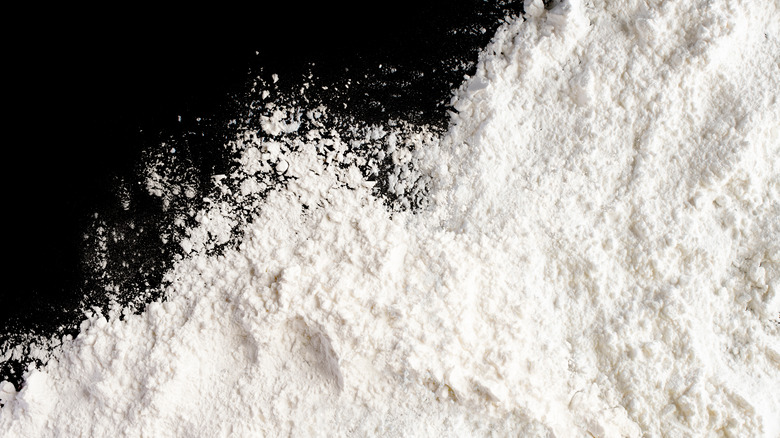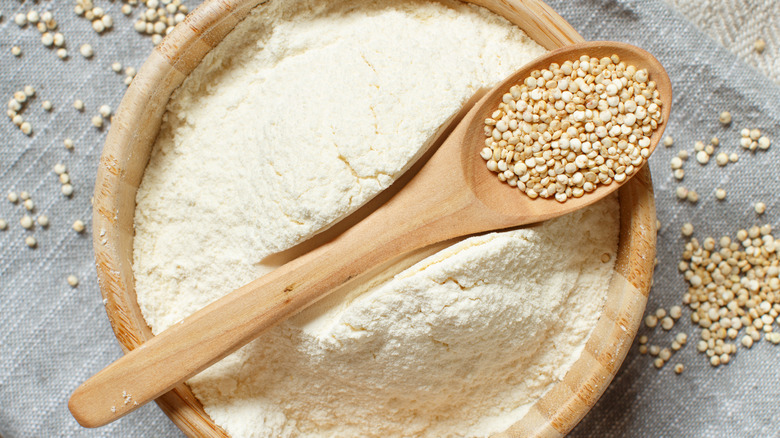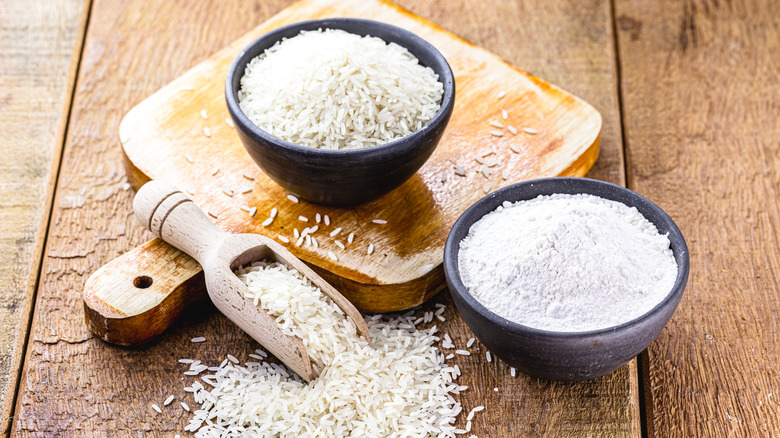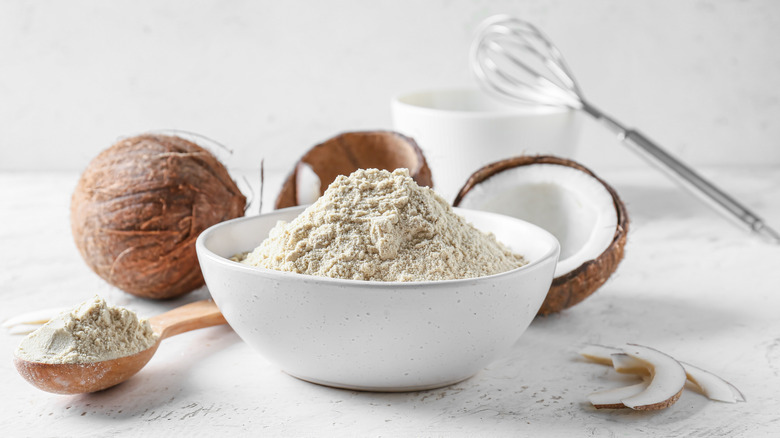9 Cake Flour Substitutes You Might Have In Your Pantry
If you're a regular baker, then you know that there are different types of flour out there, and whichever flour you choose to use can make a big difference in whatever you're baking. However, even those who are experienced in the kitchen may not know the details of every kind of flour out there. And when you find a recipe that calls for cake flour, you may wonder if it's even necessary ... or if you can substitute another ingredient.
Cake flour is ground even more finely than other types of flour, and it has less protein in it than does all-purpose flour. Because of these factors, it results in baked goods that are light and fluffy. However, you may have already found out that cake flour can be quite expensive, and it's not available everywhere. So, what exactly are you supposed to do if the recipe you're baking from calls for cake flour and you don't have any?
Don't worry. We've compiled a list of cake flour substitutes that you may already have in your pantry right now. While your cake may not turn out exactly as it would if you were to use cake flour, you can bet that these alternatives will offer a roughly similar outcome. Let's review your options.
All-purpose flour
Most people have a bag of all-purpose flour somewhere in their pantry, and it's what a lot of bakers think of when flour is called for in a recipe. But does it work as a replacement for cake flour? Well, this option is not ideal. However, we're pretty sure you have it in your pantry, and the finished product shouldn't be too different, though it might be slightly denser than you may have anticipated. You'll have to adjust the measurements, though. If your recipe calls for a cup of cake flour, you'll want to add that to your bowl and then take out two tablespoons.
While this isn't our favorite method for replacing cake flour in a recipe, you will be glad to know that it's a slightly more nutritious swap since all-purpose flour contains more protein than cake flour. You'll pay the price of a tougher cake, but in a pinch, all-purpose flour will get the job done just fine.
All-purpose flour and cornstarch
Here's one of the more popular substitutions for cake flour: all-purpose flour and cornstarch. This is a great idea because there's a fantastic chance that you already have these ingredients lying around in the kitchen. Why not put them to good use? The method for this substitution is pretty similar to what you would do with the all-purpose flour on its own. Measure out a cup, take out two tablespoons of your all-purpose flour, and then add two tablespoons of cornstarch. Mix it all well, and you're ready to use your cake flour substitution.
So, what exactly does the cornstarch do, you ask? Good question. Basically, the cornstarch adds a degree of structure and also makes the cake spongier. This happens because the cornstarch prevents too much gluten from forming. This is a fantastic option for when you don't have cake flour on hand or even if you just don't want to spend the cash on it — cake flour is notoriously pricey, after all. Keep some cornstarch stocked in your pantry so it's available to you whenever you need to use it.
All-purpose flour and arrowroot powder
This extra ingredient may not be something that you always have stocked in your pantry, but these days, it's becoming more and more common to see it in grocery stores. It's arrowroot powder, and it functions in much the same way as the cornstarch we've already discussed. The Kitchn notes that this substitution follows the same pattern: Start with a cup of all-purpose flour, and reduce it by two tablespoons. Then, instead of adding in two tablespoons of cornstarch, just replace that cornstarch with arrowroot powder instead. This will result in a cake that has that spongy quality you're going for.
There's something to keep in mind here, though. Using cornstarch and arrowroot powders will yield slightly different results. When you use arrowroot powder, you can expect your cake to cook more quickly than it otherwise would, so be sure to check on it often. Additionally, it can make your cake slightly more moist. In many cases, though, that can be a good thing — just keep this in mind if you choose to take this route.
Almond flour
A favorite among those in the gluten-free community, KitchenSeer writes that almond flour makes an excellent replacement for cake flour. The plus side? Since it's made of nuts, which are already quite moist, you're going to end up with a beautifully hydrated cake. The downside? It's certainly not appropriate for those with nut allergies. If that's not a problem, though, then you might want to keep some almond flour in the pantry. When you use it as a substitution for cake flour, you'll want to reduce the total flour by a quarter. We love that using almond flour results in a sweet and nutty taste that makes our baked goods more interesting.
Unfortunately, though, almond flour can be quite expensive depending on where you buy it. If you don't happen to have almond flour on hand but you do have a lot of almonds, you can put them in a high-speed food processor and make your own flour.
This may not be the most cost-effective substitution on the list, but it may just get you by in a pinch.
Self-rising flour
This substitution isn't as well-known, but it can still get you by in some situations. Bob's Red Mill notes that self-rising flour is actually a mixture of two different things: all-purpose flour and a rising agent, usually baking powder. Salt is also added to the flour, which means if they're included in the recipe, you're going to want to use less of those two ingredients, so you should adjust accordingly. This can be difficult if it's the first time you're tackling a recipe, but if you've made it before, you should be able to figure it out.
Why does this substitution work well? It all comes down to the protein content. Like cake flour, self-rising flour has a relatively low protein content, meaning it's going to give you a similar consistency as cake flour.
Now, would we recommend that you make this swap on the regular? Definitely not. But when you're in a pinch and don't want to have to trek all the way to the store to get cake flour, self-rising flour will do.
Quinoa flour
Admittedly, not everyone is going to have this ingredient in their pantries, but if you happen to have it on hand, you're in luck. Quinoa flour may not be the most common type of flour out there, but it's certainly gaining in popularity. It's a great option for those who are gluten-free or even just trying to cut back on gluten. However, you should know that it can be rather pricey if you're just used to using all-purpose flour.
KitchenSeer claims that quinoa flour is really easy to use as a substitution for cake flour because you can keep the ratio the same. If you're not great at math, this is great news. Also, a subtle taste of quinoa will provide your baked goods with a really lovely flavor — expect a hint of sweetness and nuttiness. While quinoa flour makes a better substitution when combined with rice or potato flour, you can also use it all on its own if that's all you have in the pantry.
Only have quinoa and no quinoa flour? No problem — you can make it yourself with a high-powered food processor. KitchenSeer notes that it even tastes similar to all-purpose flour when you toast it after processing it.
Gluten-free cake flour blend
If you want to make sure that the baked goods you're making are completely gluten-free, you may think that you have to come up with your very own cake flour blend. That can be a huge hassle, especially if you're on a budget and don't cook very often. Luckily, at some grocery and specialty stores, you should be able to find pre-prepared gluten-free cake flour blends, according to Verywell Fit. Generally, they're a combination of different flours — they may contain tapioca, potato, and/or rice flours. Make sure you take a good look at the ingredients to ensure that you're avoiding any allergens.
A lot of these gluten-free flour blends will work very well as substitutions for cake flour, but since they're all different, you won't know exactly how your baked goods are going to come out until you try it. When in doubt, we suggest googling the specific brand of flour you plan on using. That way, you can get a better sense how other bakers are using it in their kitchens.
Coconut flour
Coconut flour is also an option if you don't happen to have cake flour on hand. This too is a less common option, but it can work well in some cases. KitchenSeer recommends using coconut flour in place of cake flour in recipes for sweet breads and muffins. It will lend a slight coconut flavor to whatever you're making, but if you like coconut, it can actually be quite nice. And if you don't want to be absolutely overwhelmed by the flavor of coconut, you can always mix your coconut flour with a bit of almond flour — it generally yields good results.
However, there are some considerations you'll want to keep in mind when it comes to coconut flour. It's very absorbent, which means that you'll want to use a quarter less coconut flour than the amount of cake flour your recipe calls for. KitchenSeer also writes that you can add some more liquid to your batter as well as an extra egg per every quarter cup of coconut flour you use. This one requires some tinkering with, but in the end, it's definitely a solid option.
Pastry flour
If you happen to bake a lot, you may have some pastry flour sitting around in your kitchen. While it may not be your best option, it'll do when you just can't be bothered to get more cake flour. Like cake flour, it has less gluten than all-purpose flour, but it also has slightly more protein than cake flour, which means that you might get a denser crumb, according to Baking Kneads. In fact, they warn that it might result in a "gummy" texture. That may not sound appetizing, but we promise it's not too bad. This is another substitution that you don't have to do much math for: Just measure it out in an even ratio, and you're ready to use in your recipe.
The downside of pastry flour? It can also be kind of expensive, and it's generally not that easy to find. In fact, it's usually easier to get your hands on more cake flour than it is to chase down a bag of pastry flour. It may not be our favorite method, but it's another option that you should know about before you get baking.

